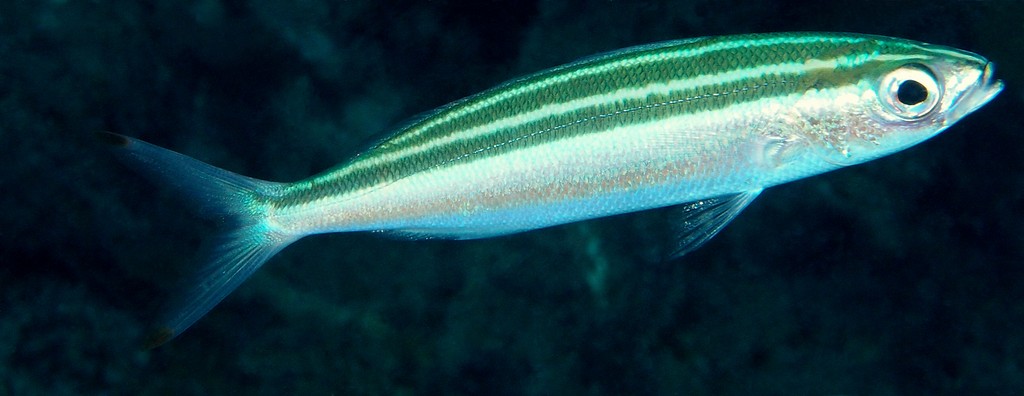PTEROCAESIO TRILINEATA - (CARPENTER, 1987)
Actinopterygii (Gigaclass) > Actinopteri (Class) > Teleostei (Subclass) > Lutjaniformes (Order) > Lutjanidae (Family) > Lutjaninae (Subfamily) > Pterocaesio (Genus)
Fusilier à trois bandes, Striped fusilier, Three-lined fusilier, Three-stripe fusilier, Three-striped fusilier, Threestripe fusilier, Fusilero de tres bandas, Issentakasago, イッセンタカサゴ, 세줄가는돔, 三帶鱗鰭梅鯛,
Synonymes
Caesio trilineata (Carpenter, 1987)
Pterocaesio trilineatus (Carpenter, 1987)
Squamosicaesio trilineata (Carpenter, 1987)
Fusilier à trois bandes, Striped fusilier, Three-lined fusilier, Three-stripe fusilier, Three-striped fusilier, Threestripe fusilier, Fusilero de tres bandas, Issentakasago, イッセンタカサゴ, 세줄가는돔, 三帶鱗鰭梅鯛,
Synonymes
Caesio trilineata (Carpenter, 1987)
Pterocaesio trilineatus (Carpenter, 1987)
Squamosicaesio trilineata (Carpenter, 1987)
------------------------
Description
Dorsal spines (total): 10-11; Dorsal soft rays (total): 14-16; Anal spines: 3; Anal soft rays: 11-12; Pectoral fin rays: 19-21 (usually: 20). Scales in lateral line: 63-69; Upper peduncular scale rows: 11, lower peduncular scale rows : 15; Scale rows above lateral line to origin of dorsal fin: 8-9; Scale rows below lateral line to origin of anal fin: 14-17 (usually: 15); Scale rows on cheek: 4; Predorsal scales: 20-30; Dorsal and anal fin scaled the dorsal with about 1/3 of the height of its spinous part covered with scales; Supratemporal band of scales confluent at dorsal midline. Body fusiform, elongate and moderately compressed. Two postmaxillary processes; Small conical teeth in jaws; Vomer and palatines without teeth. Process on basioccipital flat for insertion of Baudelot's ligament. Head length: 2.8-3.9 in SL; Body depth: 3.3-4.9 in SL. Max. length: 20.0 cm TL, common length: 13.0 cm SL. Depth range: 1 - 30 m.
Color
Three dark brown to yellow and three light bluish white longitudinal stripes on upper side; Lowest dark stripe about two scales wide, originating on snout and upper orbit, and covering the lateral line for most of its length, running dorsal to lateral line on caudal peduncle; Middle dark stripe about two scales wide, originating on snout, running about midway between dorsal profile and lower dark stripe; Uppermost stripe originating on snout and straddling the dorsal profile for about one scale to either side; Bluish white stripes, about 1-1.5 scales wide, covering the spaces between the dark stripes and just below the lowest dark stripe; Body whitish ventrally; Pectoral, pelvic, and anal fins white; Axil of pectoral fin black; Dorsal fin light bluish; Caudal fin dusky with lobe tips black.
Etymology
Pterocaesio: from Greek, pteron = wing, fin + from Latin, caesius = blue-grey or bluish-grey.
trilineata: from Latin prefix, tri- = three + from Latin, lineatus = lined. Referring to three dark stripes and three alternating light stripes on upper side of body in life (stripes become less visible after death and are often totally obscured in preservation).
Original description: Pterocaesio trilineata Carpenter, 1987 - Type locality: Dravuni Island, Kandavu Island, Fiji Islands, depth 4-6 meters.
Distribution
Indo-West Pacific: eastern Indonesia east to Marshall Islands and Fiji, north to southern Sea of Japan, south to Queensland (Australia), New Caledonia and Norfolk Island.
Dorsal spines (total): 10-11; Dorsal soft rays (total): 14-16; Anal spines: 3; Anal soft rays: 11-12; Pectoral fin rays: 19-21 (usually: 20). Scales in lateral line: 63-69; Upper peduncular scale rows: 11, lower peduncular scale rows : 15; Scale rows above lateral line to origin of dorsal fin: 8-9; Scale rows below lateral line to origin of anal fin: 14-17 (usually: 15); Scale rows on cheek: 4; Predorsal scales: 20-30; Dorsal and anal fin scaled the dorsal with about 1/3 of the height of its spinous part covered with scales; Supratemporal band of scales confluent at dorsal midline. Body fusiform, elongate and moderately compressed. Two postmaxillary processes; Small conical teeth in jaws; Vomer and palatines without teeth. Process on basioccipital flat for insertion of Baudelot's ligament. Head length: 2.8-3.9 in SL; Body depth: 3.3-4.9 in SL. Max. length: 20.0 cm TL, common length: 13.0 cm SL. Depth range: 1 - 30 m.
Color
Three dark brown to yellow and three light bluish white longitudinal stripes on upper side; Lowest dark stripe about two scales wide, originating on snout and upper orbit, and covering the lateral line for most of its length, running dorsal to lateral line on caudal peduncle; Middle dark stripe about two scales wide, originating on snout, running about midway between dorsal profile and lower dark stripe; Uppermost stripe originating on snout and straddling the dorsal profile for about one scale to either side; Bluish white stripes, about 1-1.5 scales wide, covering the spaces between the dark stripes and just below the lowest dark stripe; Body whitish ventrally; Pectoral, pelvic, and anal fins white; Axil of pectoral fin black; Dorsal fin light bluish; Caudal fin dusky with lobe tips black.
Etymology
Pterocaesio: from Greek, pteron = wing, fin + from Latin, caesius = blue-grey or bluish-grey.
trilineata: from Latin prefix, tri- = three + from Latin, lineatus = lined. Referring to three dark stripes and three alternating light stripes on upper side of body in life (stripes become less visible after death and are often totally obscured in preservation).
Original description: Pterocaesio trilineata Carpenter, 1987 - Type locality: Dravuni Island, Kandavu Island, Fiji Islands, depth 4-6 meters.
Distribution
Indo-West Pacific: eastern Indonesia east to Marshall Islands and Fiji, north to southern Sea of Japan, south to Queensland (Australia), New Caledonia and Norfolk Island.
Biology
Ranges widely around coral reefs. Feeds on zooplankton in midwater aggregations. Oviparous, with numerous, small pelagic eggs. Not common as a food fish. A fairly important tuna baitfish in the western Pacific.
Ranges widely around coral reefs. Feeds on zooplankton in midwater aggregations. Oviparous, with numerous, small pelagic eggs. Not common as a food fish. A fairly important tuna baitfish in the western Pacific.
Last update: 21, August 2022
